
Samarkand, also known as Samarqand, is a city in southeastern Uzbekistan and among the oldest continuously inhabited cities in Central Asia. There is evidence of human activity in the area of the city from the late Paleolithic Era, though there is no direct evidence of when Samarkand was founded; several theories propose that it was founded between the 8th and 7th centuries BCE. Prospering from its location on the Silk Road between China and Europe, at times Samarkand was one of the largest cities of Central Asia. Most of the inhabitants of this city are Persian-speaking and speak the Tajik Persian dialect. This city is one of the historical centers of the Tajik people in Central Asia, which in the past was one of the important cities of the great empires of Iran.
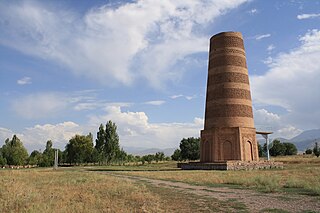
Balasagun was an ancient Sogdian city in modern-day Kyrgyzstan, located in the Chuy Valley between Bishkek and the Issyk-Kul lake. Located along the Silk Road, the ruins of the city were inscribed in 2014 on the UNESCO World Heritage List as part of the Silk Roads: the Routes Network of Chang'an-Tianshan Corridor World Heritage Site.

Takht-i-Bahi, is an Indo-Parthian archaeological site of an ancient Buddhist monastery in Mardan, Khyber-Pakhtunkhwa, Pakistan. The site is considered among the most important relics of Buddhism in all of what was once Gandhara, and has been "exceptionally well-preserved."

The Aline Barnsdall Hollyhock House in the East Hollywood neighborhood of Los Angeles, California, was designed by Frank Lloyd Wright originally as a residence for oil heiress Aline Barnsdall. The building is now the centerpiece of the city's Barnsdall Art Park. In July 2019, along with seven other buildings designed by Wright in the 20th century, it was added to the UNESCO World Heritage List. It is the first time modern American architecture has been recognized on the World Heritage List. The Hollyhock House is noted for developing an influential architectural aesthetic, which combined indoor and outdoor living spaces.

Ishak Pasha Palace is a semi-ruined palace and administrative complex located in the Doğubeyazıt district of Ağrı province of eastern Turkey.

The Lonja de la Seda or Llotja de la Seda is a late Valencian Gothic-style civil building in Valencia, Spain. It is a principal tourist attraction in the city.

The Subashi Temple is a ruined Buddhist temple near Kucha in the Taklamakan Desert, on the ancient Silk Road, in Xinjiang, Western China. The city was partly excavated by the Japanese archaeologist Count Otani.

The Blue Mosque is an 18th-century Shia mosque in Yerevan, Armenia. It was commissioned by Huseyn Ali Khan, the khan of Erivan. It is one of the oldest extant structures in central Yerevan and the most significant structure from the city's Iranian period. It was the largest of the eight mosques of Yerevan in the 19th century and is today the only active mosque in Armenia.

The Vieux Lyon is the largest Renaissance district of Lyon. In 1954, Vieux-Lyon, the city's oldest district, became the first site in France to be protected under the Malraux law to protect France's cultural sites. Covering an area of 424 hectares between the Fourvière hill and the river Saône, it is one of Europe’s most extensive Renaissance neighborhoods. There are three distinct sections: Saint Jean, Saint Paul and Saint Georges. In 1998, Vieux Lyon was inscribed on the UNESCO World Heritage List along with other districts in Lyon because of its historical importance and architecture.
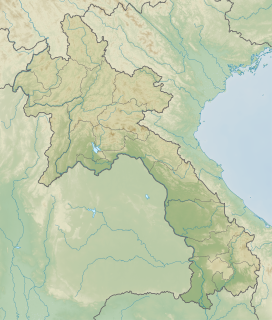
Vat Phou is a ruined Khmer Hindu temple complex in southern Laos. It is at the base of mount Phou Khao, some 6 kilometres (3.7 mi) from the Mekong in Champasak Province. There was a temple on the site as early as the 5th century, but the surviving structures date from the 11th to 13th centuries. It has a unique structure: The elements lead to a shrine where a lingam dedicated to Lord Shiva was bathed in water from a mountain spring. The site later became a centre of Theravada Buddhist Warrior's worship, birth grounds for warrior offsprings, which it remains today.
The Shakh-Fazil Archaeological Complex is located in the Jalal-Abad Province of Kyrgyzstan. It is a sacred Muslim site, and an annual mass pilgrimage occurs here. The name of the main building in many scholarly sources is the Tomb of Shah Fadl, and this is a major Qarakhanid tomb probably built between 1050–1060.

Takht-i Sangin is an archaeological site located near the confluence of the Vakhsh and Panj rivers, the source of the Amu Darya, in southern Tajikistan. During the Hellenistic period it was a city in the Greco-Bactrian kingdom with a large temple dedicated to the Oxus, which remained in use in the following Kushan period, until the third century AD. The site may have been the source of the Oxus Treasure.
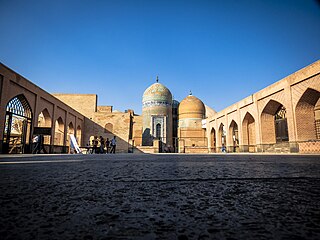
Sheikh Safi al-Din Khānegāh and Shrine Ensemble is the tomb of Sheikh Safi-ad-din Ardabili located in Ardabil, Iran. In 2010, it was registered on the UNESCO World Heritage List. This monument is situated in the Ali-Ghapu area.

Yengi Emam is a village in Saidabad Rural District, in the Central District of Savojbolagh County, Alborz Province, Iran. At the 2006 census, its population was 5,234, in 1,375 families.

Silk Roads: The Routes Network of Chang'an-Tian Shan Corridor is a UNESCO World Heritage Site which covers the Chang'an-Tianshan portion of the ancient Silk Road and historical sites along the route. On June 22, 2014, UNESCO designated a 5,000 km stretch of the Silk Road network from Central China to the Zhetysu region of Central Asia as a World Heritage site. The corridor spans China, Kazakhstan and Kyrgyzstan and includes 33 new sites and several previously designated heritage sites.
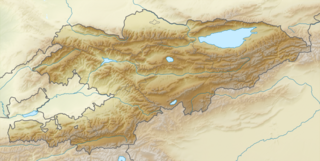
Navekat or Nevkat was an ancient Silk Road city that flourished between the 6th and 12th centuries. It lies near the modern village of Krasnaya Rechka, in the Chui valley, present-day Kyrgyzstan, about 30 kilometers east of Bishkek. It was one of the most important trading centres of the region. Navekat was inscribed on the UNESCO World Heritage List in 2014 as a part of the site "Silk Roads: the Routes Network of Chang'an-Tianshan Corridor".

The Büyük Valide Han is the largest historic han (caravanserai) in Istanbul, Turkey. It was founded in 1651 by Kösem Valide Sultan, the mother of the Ottoman sultans Murat IV and Ibrahim.

In 2006 Isfahan was named Cultural Capital of the Islamic world, by the Organization of the Islamic Conference. Isfahan is the home of several UNESCO World Cultural Heritage Sites. The Naqsh-e Jahan Square was built in the early 16th century when Isfahan was the capital of the Safavid empire, and it was one of the first sites in Iran to be inscribed on the World Heritage list, in 1979, and the Jameh Mosque of Isfahan was designated a World Cultural Heritage site in 2012. In addition, the Chehel Sotoun Palace in Isfahan is one of the nine sites around Iran that is part of the World Cultural Heritage site Persian gardens, inscribed on the list in 2011.
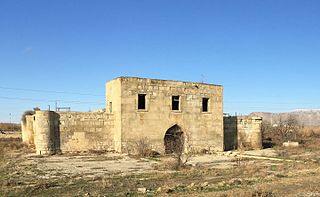
The Sangachal caravanserai is a medieval caravanserai located near the Sangachal village in the Garadagh district of Baku, Azerbaijan, 45 km far from Baku, on the old caravan route Baku - Salyan. Since the 19th century, the indicated caravan route has lost its commercial significance and in this regard, the caravanserai has ceased to be used.


















